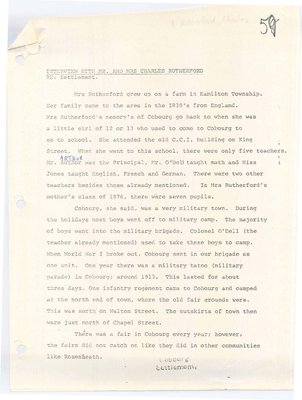RE: Settlement.
Mrs. Rutherford grew up on a farm in Hamilton Township. Her family came to the area in the 1830s from England. Mrs. Rutherford’s memory of Cobourg to go back to when she was a little girl of 12 or 13 who used to come to Cobourg to go to school. She attended the old C.C.I. building on King Street. When she went to this school, there were only five teachers. Mr. Arthur was the Principal, Mr. O’Dell taught math and Miss Jones taught English, French and German. There were two other teachers besides those already mentioned. In Mrs. Rutherford’s mother’s class of 1876, there were seven pupils.
Cobourg, she said, was a very military town. During the holidays most boys went off to military camp. The majority of boys went into the military brigade. Colonel O’Dell (the teacher already mentioned) used to take these boys to camp. When World War I broke out, Cobourg sent in our brigade as one unit. One year there was a military tattoo (military parade) in Cobourg; around 1913. This lasted for about three days. One infantry regiment came to Cobourg and camped at the north end of town, where the old fair grounds where. This was north on Walton Street. The outskirts of town then were just north of Chapel Street.
There was a fair in Cobourg every year; however; the fairs did not catch on like they did in other communities like Roseneath.
She also remembered the Cobourg Horse Show. It was just as good as any in Southern Ontario. Horses were brought from all over Ontario and the United States. It was held in Donegan Park, which in those days was known as Horse Show Park. Mrs. Rutherford remembers a woman by the name of Mrs. Livingston, who was from the States, who used to raise horses in Canada because she felt that northern air was better for them.


